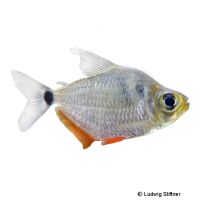Spotlight Tetra (Tetragonopterus argenteus)
| Spotlight Tetra Tetragonopterus argenteus | |
|---|---|
| Name | Spotlight Tetra |
| Name Lat. | Tetragonopterus argenteus |
| Family | Characins |
| Family lat. | Characidae |
| Order | Characins |
| Order lat. | Characiformes |
| Origin | South America |
| Habitat | Rivers |
| Diet | Omnivore |
| pH | 6.0-7.5 |
| Behavior | Peaceful |
| Keeping | Group |
| Care Level | Easy |
| Reproduction | Egg scatterer |
| Breeding | Simple |
| Life Span | 3-5 years |
| Protection | No |
| Metric Units | |
| Size | 8-10 cm |
| Temperature | 22-27 °C |
| Hardness | 5-20 °dH |
| Aquarium | ~ 250 l |
| US Units | |
| Size | 3"-4" |
| Temperature | 72-81 °F |
| Hardness | 89-356 ppm |
| Aquarium | ~ 65 gal |
Distribution and habitat
The Fringed Shiner Tetra is found in the tributaries of the Amazon River (Brazil, Venezuela) and the La Plata River (Paraguay). There they live in slow-flowing streams and rivers with overhanging, dense and therefore shady riparian vegetation.
Maintenance
The aquarium should have partly dense and varied planting, providing both shelter and swimming space. A dark substrate covered with some foliage (e.g. sea almond leaves), subdued light (floating plant cover) and soft, slightly acidic water with a weak current is ideal.
No ammonia, ammonium or nitrite should be detectable, and the nitrate value should not exceed 100 mg/l. To ensure the water quality and oxygen content, a filter and heater adapted to the aquarium size is required, as well as lighting for the species-appropriate day-night rhythm of the animals.
Diet
The food supply consists of live, frozen and dry food. For a balanced diet, feed once a day with a high-quality dry food (flakes, granules, pellets) as well as cyclops, daphnia, mosquito larvae or artemia (live or frozen). In addition, they occasionally need some vegetable food, such as algae leaves or dry food with vegetable ingredients (e.g. spirulina)
It is recommended to feed small portions several times a day. Only feed as much as is eaten within a few minutes. A regular and varied diet promotes health and prevents deficiency symptoms
Behaviour and compatibility
They are lively but peaceful schooling fish, well suited for any community tank with other peaceful fish. At least 5, but preferably much more Fringed Shiner Tetras should be kept together
Basically, only fish species that are compatible with each other and have similar water condition and water temperature requirements should be socialized
Sex dimorphism
The somewhat slimmer males have longer extended dorsal fins than the more rounded appearing females.
Reproduction and breeding
In soft, slightly acidic peat water they spawn mostly between fine-feathered plants up to 300 eggs, which remain attached to the leaves or the discs. The larvae hatch after about 24 hours and swim freely after 4-5 days.
Fry must be fed several times a day with special rearing food (e.g. Artemia nauplii, dust food). In a community tank breeding is hardly possible, because the spawn is easy prey.
Important
Feeding plant foods reduces the risk of fish eating the tender shoots of aquatic plants.
The well-being of the fish should be checked regularly. Temperature should be checked daily, pH, hardness and nitrate levels at least every 14 days. Regular partial water changes are recommended, even if the contaminant level has not yet reached the upper limit. Sudden changes in water quality should be avoided. Newly introduced fish must be accustomed slowly to the water in the aquarium.
Further literature can be found in your pet store.
References
Text: petdata; Image: Ludwig Stifter
Source: BMELV (1998): Tierschutzgutachten - Haltung von Zierfischen (Süßwasser); RIEHL & BAENSCH (2006): Aquarien Atlas Bd. 1, Mergus Verlag; ENGELMANN (2005): Zootierhaltung - Tiere in menschlicher Obhut: Fische, Verlag Harri Deutsch
- Gemäß § 21 Abs. 5 Tierschutzgesetz idgF
